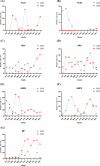Epidemiological characteristics of respiratory pathogens infections among children after the removal of non-pharmaceutical interventions in central China
- PMID: 39587598
- PMCID: PMC11590254
- DOI: 10.1186/s12985-024-02579-5
Epidemiological characteristics of respiratory pathogens infections among children after the removal of non-pharmaceutical interventions in central China
Abstract
Background: During the COVID-19 pandemic between 2020 and 2022 in China, various non-pharmaceutical interventions (NPIs) were implemented to reduce the spread of SARS-CoV-2 and other respiratory pathogens. From 2023, China downgraded the management of COVID-19, and compliance with NPIs was no longer mandatory. This study aimed to reveal the epidemiological characteristics of respiratory pathogens in 2023 after the removal of NPIs in central China.
Methods: Respiratory specimens of children with acute respiratory infections (ARIs) were obtained to detect seven common respiratory pathogens, including influenza A (FluA), influenza B (FluB), adenovirus (ADV), human rhinovirus (HRV), human respiratory syncytial virus (HRSV), human metapneumovirus (HMPV), Mycoplasma pneumoniae (MP). From January 2022 to December 2023, a total of 5423 specimens were collected, including 1122 children in 2022 and 4301 children in 2023.
Results: One or more pathogens were detected in 62.50% specimens in 2023, significantly higher than that in 2022 (44.12%). HRV (13.81%) was the most common pathogen in 2022, whereas MP (24.67%) was predominant in 2023. There was no significant difference in the overall prevalence of HRV, HRSV and HMPV between 2022 and 2023. HRSV was the most common pathogen in the < 1 years children both in 2022 and 2023. However in the ≥ 7 years group, FluB was the predominant pathogen in 2022 whereas MP ranked first in 2023. Co-detection were significantly more frequent in 2023 compared to 2022.
Conclusions: The removal of NPIs significantly increased the infection rates of the respiratory pathogens among children. Some NPIs, such as wearing mask and hand hygiene are necessary to decrease the prevalence of certain pathogens.
Keywords: COVID-19; Epidemiological characteristics; Jingzhou; Non-pharmaceutical interventions; Respiratory pathogens.
© 2024. The Author(s).
Conflict of interest statement
Declarations. Ethics approval and consent to participate: All procedures performed in this study involving human participants were in accordance with the Declaration of Helsinki (as revised in 2013). The study was approved by the Ethical Committee of Jingzhou Hospital Affiliated to Yangtze University (2023-073-01). Consent for publication: Not applicable. This manuscript does not contain any persons data in any form. Competing interests: The authors declare that they have no competing interests.
Figures




Similar articles
-
Epidemiology of respiratory pathogens in patients with acute respiratory infections during the COVID-19 pandemic and after easing of COVID-19 restrictions.Microbiol Spectr. 2024 Nov 5;12(11):e0116124. doi: 10.1128/spectrum.01161-24. Epub 2024 Sep 25. Microbiol Spectr. 2024. PMID: 39320069 Free PMC article.
-
Epidemiological characteristics of six common respiratory pathogen infections in children.Microbiol Spectr. 2025 Jul;13(7):e0007925. doi: 10.1128/spectrum.00079-25. Epub 2025 May 22. Microbiol Spectr. 2025. PMID: 40401960 Free PMC article.
-
Prevalence of respiratory pathogens and risk of developing pneumonia under non-pharmaceutical interventions in Suzhou, China.Epidemiol Infect. 2023 May 2;151:e82. doi: 10.1017/S0950268823000626. Epidemiol Infect. 2023. PMID: 37127406 Free PMC article.
-
Characterising the asynchronous resurgence of common respiratory viruses following the COVID-19 pandemic.Nat Commun. 2025 Feb 13;16(1):1610. doi: 10.1038/s41467-025-56776-z. Nat Commun. 2025. PMID: 39948338 Free PMC article.
-
Lethal Synergistic Infections by Two Concurrent Respiratory Pathogens.Arch Med Res. 2025 Jan;56(1):103101. doi: 10.1016/j.arcmed.2024.103101. Epub 2024 Oct 24. Arch Med Res. 2025. PMID: 39454459 Review.
Cited by
-
hMPV Outbreaks: Worldwide Implications of a Re-Emerging Respiratory Pathogen.Microorganisms. 2025 Jun 27;13(7):1508. doi: 10.3390/microorganisms13071508. Microorganisms. 2025. PMID: 40732017 Free PMC article. Review.
-
Epidemiology of respiratory infections during the different levels of non-pharmaceutical interventions.BMC Pediatr. 2025 May 11;25(1):375. doi: 10.1186/s12887-025-05723-4. BMC Pediatr. 2025. PMID: 40350431 Free PMC article.
-
The prevalence trends of Trichomonas vaginalis infection among women in Jingzhou, central of China, 2019-2023.BMC Infect Dis. 2025 Mar 28;25(1):435. doi: 10.1186/s12879-025-10815-8. BMC Infect Dis. 2025. PMID: 40155817 Free PMC article.
References
-
- Troeger C, Blacker B, Khalil IA. Collaborators GBDLRI: Estimates of the global, regional, and national morbidity, mortality, and aetiologies of lower respiratory infections in 195 countries, 1990–2016: a systematic analysis for the global burden of disease study 2016. Lancet Infect Dis. 2018;18(11):1191–210. - PMC - PubMed
-
- Williams BG, Gouws E, Boschi-Pinto C, Bryce J, Dye C. Estimates of world-wide distribution of child deaths from acute respiratory infections. Lancet Infect Dis. 2002;2(1):25–32. - PubMed
-
- Rudan I, Chan KY, Zhang JS, Theodoratou E, Feng XL, Salomon JA, Lawn JE, Cousens S, Black RE, Guo Y, et al. Causes of deaths in children younger than 5 years in China in 2008. Lancet. 2010;375(9720):1083–9. - PubMed
Publication types
MeSH terms
Grants and funding
- 2022BCE029/Key Research and Development Plan Project Supporting Local Special Funds in the Field of Comprehensive Health of Hubei Province
- 2022BCE029/Key Research and Development Plan Project Supporting Local Special Funds in the Field of Comprehensive Health of Hubei Province
- 2023KF007/Open Research Fund Program of the State Key Laboratory of Virology of China
LinkOut - more resources
Full Text Sources
Medical
Miscellaneous

